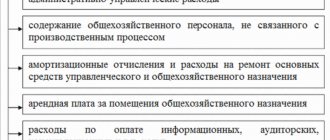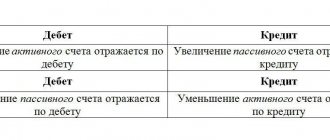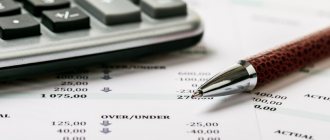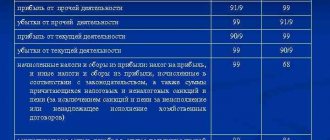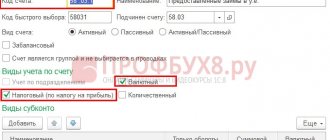Meaning of account for accounting
This position in the Chart of Accounts, referred to as “main production,” is intended to summarize data on the costs incurred in the process of creating goods, works or services. In more detail, this position is used to account for costs such as:
- creation of goods for industrial and agricultural purposes;
- carrying out geological exploration, industrial construction and other works;
- services related to the organization of transportation and communications;
- carrying out research and development work;
- repair and maintenance of highways.
The debit side of the company reflects direct costs associated directly with the company's main activities, as well as indirect costs and expenses of auxiliary production. In the first case, expenses are written off to accounts where production inventories, employee payroll, etc. are taken into account. If we talk about auxiliary production, then in this situation there is a write-off to account 20 from the credit part of position 23, referred to as “auxiliary production”.
If at the end of the reporting period there remains a certain balance at the designated position, then it reflects the value of work in progress. As for analytical accounting, it is carried out taking into account the type of costs and the type of products produced.
What does the posting “debit 20 credit 20” mean?
Strictly speaking, wiring Dt 20 Kt 20 is not completely correct. Its physical meaning is that the result of the main production is sent to the main production. The transaction turnover actually doubles in the consolidated turnover for account 20, which requires further measures to clarify the data (for example, to determine the volume of gross output for the period, it is necessary to exclude intra-production turnover from the gross turnover (entirely Dt 20) (Dt 20 Kt 20)).
Therefore, wiring is more often used in those industries where a complex production cycle takes place. When one department produces something that can be both a finished product and a material (raw material) for another department. For example:
- In agriculture. On a meat and dairy farm, via Dt 20 Kt 20, the milk is sent to feed calves, which are fattened for slaughter.
- In petrochemical production. The primary refining of crude oil produces a variety of products that can be used for various purposes, including being returned to the production cycle at the same enterprise. For example, Dt 20 Kt 20 can reflect the use of part of the industrial gas obtained at one’s own production for the needs of the production itself.
In practice, Dt 20 Kt 20 can also be used in cases where the accounting policy does not provide for the maintenance of separate accounts for accounting for the production of own semi-finished products (account 21) and the products of auxiliary production (account 23). Then the formation of the cost goes along the chain, by transfer from stage to stage (from workshop to workshop), and the transfer is formalized Dt 20 Kt 20 in the analytics of subaccounts by stages (shops).
Find out how to properly account for and distribute expenses in ConsultantPlus. To do everything right, get a trial demo access to the K+ system and go to the Typical situation.
Methods for closing an account
First, you should remember the rule according to which the chosen closing method must be recorded in the company’s accounting policies. In general, there are closure methods such as:
- direct method;
- intermediate;
- direct sale of manufactured products.
Before you begin to close the designated account, you should determine the balance of work in progress.
So, if we are talking about a direct method, then its use is possible in a situation where the actual price of manufactured products is not yet known, and accounting for manufactured goods is carried out at conditional prices, for example, at planned cost.
At the end of the reporting period, the company adjusts the price of its products to the actual price. Thus, the direct method of closing in transactions is as follows:
- Dt 43
Kt 20 – correction of the cost of goods produced;
- Dt 90.02
Kt 43 – reflects the deviation of the actual price from the planned price.
It is important to remember that within the framework of this method it is not possible to account for manufactured products at actual cost during the reporting month.
As for the intermediate method, its application will require account 40, which takes into account the amount of deviation of the actual cost of goods produced from the planned one. The credit part should reflect the planned cost, and the debit part should reflect the actual cost.
At the end of the reporting period, the accumulated amount of deviations is proportionally written off to 43 and 90.02 positions. Thus, the accounting entries within this method will look like this:
- Dt 43
Kt 40 – posting of finished products at the planned price;
- Dt 90.02
Kt 43 – write-off of goods sold at planned cost.
Account 20 is closed at the end of the month with the following entries:
- Dt 40
Kt 20 – write-off of actual cost;
- Dt 43
Kt 40 – correction of planned cost to actual cost;
- Dt 90.02
Kt 40 - correction of planned cost to actual cost.
As part of the direct sales method, finished products are not taken into account in the warehouse, but are written off immediately from production.
How is the financial result determined on account 90
To do this, accounting entries are made such as Dt 90 Kt 20, Dt 90 Kt 43 , Dt 90 Kt 41, Dt 90 Kt 68, Dt 90 Kt 90, Dt 99 Kt 90, Dt 90 Kt 99, Dt 99 Kt 90. Let's consider Learn more about the logic of posting Dt 90 Kt 90 and other accounting operations to determine the financial result using an example.
Example
Sdoba LLC operates at OSN. In December 2015, it purchased raw materials in the amount of RUB 1,180,000. with VAT for the production of confectionery products.
The following entries were made in accounting:
- Dt 10 Kt 60 - 1,000,000 rub. (raw materials for the production of buns have arrived at the warehouse);
- Dt 19 Kt 60 - 180,000 rub. (VAT on purchased raw materials);
- Dt 68 Kt 19 - 180,000 rub. (VAT on raw materials is accepted for deduction);
- Dt 20 Kt 10 - 1,000,000 rub. (raw materials transferred to production).
The confectioners made 20,000 buns from the received raw materials and transferred them to the finished goods warehouse. You can account for manufactured products in different ways. Sdoba LLC does this without using account 40, arriving ready-made bakery products at actual cost directly to account 43.
For other ways to account for finished products, read the article “How finished products are reflected in the balance sheet.”
Dt 43 Kt 20 - 20,000 buns were accepted into the warehouse at an actual cost of 50 rubles. a piece.
Next, an order was received from a buyer for 5,000 buns at a price of 65 rubles. a piece. After the products are shipped, the accountant will make the following entries in the accounting records:
- Debit 90 Credit 43 - in the amount of 5,000 × 50 rubles. = 250,000 rub. (sold buns are written off from the warehouse at actual cost).
- Dt 62 Kt 90.1 - in the amount of 5,000 × 65 rubles. = 325,000 rub. (sales revenue includes VAT).
The accountant will record the amount of VAT on buns sold by writing: Debit 90 Credit 68 - 49,576.27 rubles.
Next, at the end of December, the accountant must determine the financial results of the company.
Debit turnover on the account is 90 - 250,000 rubles. (cost of buns) + 49,576.27 rub. (VAT), and a total of 299,576.27 rubles.
Credit turnover on the account is 90 - 325,000 rubles. (proceeds from the sale of buns).
At the end of December, the accountant of Sdoba LLC will close each of the subaccounts of account 90 with entries Dt 90 Kt 90 to 90.9.
Since the amount of credit turnover is greater than debit turnover, the company made a profit. In this case, the accountant uses the accounting entry: Debit 90 Credit 99 - 50,423.73 rubles. (profit was recorded at the end of the month).
If Sdoba LLC ended the month with losses, the accountant would make an entry in the accounting: Dt 99 Kt 90.9.
Closing the annual turnover on account 90 will be carried out by postings Dt 90 Kt 90 to the corresponding subaccounts:
- Dt 90.1 Kt 90.9 - RUB 325,000;
- Dt 90.9 Kt 90.2 - RUB 250,000;
- Dt 90.9 Kt 90.3 — 49,576.27 rub.
If a company opens its own subaccounts to account 90, then by posting Dt 90 Kt 90 it will have to close both the subaccounts provided for by law and its own.
Since the vast majority of companies conduct accounting using computer programs, the program automatically posts Dt 90 Kt 90 when performing the “Month Closing” operation.
Practical examples
Let's imagine a situation where a certain organization provides repair services. Thus, during the reporting period, repair services were provided, the total cost of which was 30,000 rubles, and the planned cost was 25,000 rubles.
The volume of production costs amounted to 27,000 rubles, including:
- material costs - 5,000 rubles;
- the amount of depreciation charges is 1,790 rubles;
- labor costs – 23,045 rubles.
In this case, the accounting entries will be as follows:
- costs of creating a product:
Dt 20
Kt 10 – 5,000 rubles, write-off of material costs for the production process;
- carrying out repair work:
Dt 62
Kt 90.01 – 35,400 rubles, sales revenue;
Dt 90.03
Kt 68 – RUR 5,400, value added tax charged;
Dt 90.02
Kt 20 – 25,000 rubles, the planned cost is written off;
- payroll for production workers:
Dt 20
Kt 70 – 20,000 rub.,;
Dt 70
Kt 68 – 2,600 rubles, income tax withholding;
Dt 20
Kt 69 – 3,045 rubles, withholding of insurance premiums.
- closing entries at the end of the reporting period:
Dt 90.02
Kt 20 – 2,000 rubles, correction of the cost of services provided.
In what cases are entries made for Debit 90 and Credit 90, 68, 43, 99, 20
According to the chart of accounts (approved by order of the Ministry of Finance of Russia dated October 31, 2000 No. 94n), account 90 is needed to generate information about the company’s income and expenses for its main type of activity, as well as to determine the financial result of its business operations. For analytical purposes, subaccounts are opened to account 90 to record revenue (90.1), cost (90.2), VAT, excise taxes and export duties (90.3, 90.4 and 90.5, respectively), and financial results (90.9).
Accounting for subaccounts of account 90 must be kept cumulatively throughout the year. Every month, the accountant compares sales revenue with cost, VAT (if necessary, excise taxes and export duties) and writes off the final financial result to account 99. At the same time, there is no balance on account 90 as of the reporting date. At the end of the year, all subaccounts of account 90 (except 90.9) will be closed with internal postings Dt 90 Kt 90 , and subaccount 90.9, in turn, will be closed on account 99.
Account 20: accounting entries
Let's look at typical accounting entries for recording operations related to core activities.
| Operation | Account debit | Account credit |
| Inventories were transferred to our own production | 20 | 10 |
| Salaries and insurance contributions of personnel directly involved in the main activities are included in the OP | 20 | 70 69 |
| Services of third-party companies are included in the costs of OP | 20 | 60 |
| Write-off of management expenses reflected | 20 | 26 |
| General production costs are written off to OP | 20 | 25 |
| Returns for reworking of finished products that were found to be defective are reflected. | 20 | 43 |
| Manufacturing defects identified prior to sale are sent for processing | 20 | 28 |
| Amounts of taxes and fees are allocated to production needs | 20 | 68 |
| Deficiencies and losses are reflected within the norms in the production process, without persons at fault | 20 | 94 |
| Downtime and claims against contractors | 20 | 76/2 |
| Semi-finished products are sent to the production process | 20 | 21 |
| The costs of auxiliary production are reflected in the OP | 20 | 23 |
| The goods were written off for the company's production needs | 20 | 41 |
| Reflects the report issued to the employee for production needs | 20 | 71 |
| The employee was compensated for costs associated with the production process (compensation for fuel and lubricants for the use of a personal car, for example) | 20 | 73 |
| Work in progress was accepted as part of targeted financing | 20 | 86 |
| Work in progress is reflected as a contribution to the authorized capital of the organization | 20 | 80 |
| Excess work in progress is taken into account | 20 | 91/1 |
| The share of deferred expenses was attributed to the OP | 20 | 96 |
Features of accounting on an account 20
All expenses that the company incurs on its main activities or production are accumulated on active account 20. When accepting expenses for accounting, the accounting account is debited; when releasing finished products or providing services, the entries are credited.
A feature of accounting account 20 is that debit turnover cannot be greater than credit turnover. This means that the company cannot consume more raw materials than were written out from warehouses for the production process. Similar conditions apply to other types of expenses.
Postings to account 20 collect information about the cost of OP for the reporting period. In addition to inventories, the following can be written off as main production:
- salaries of key personnel;
- depreciation of equipment;
- administrative staff salaries;
- expenses for renting premises, paying for utilities;
- other expenses.
